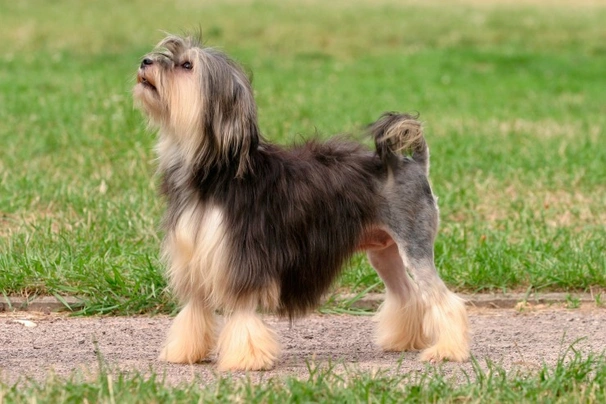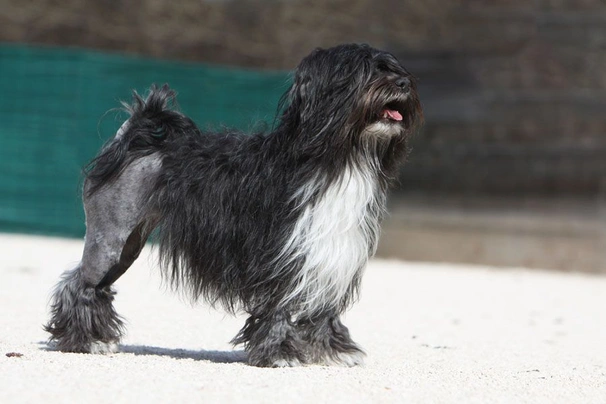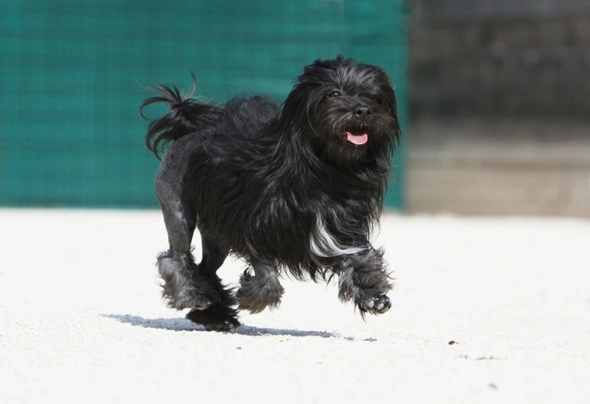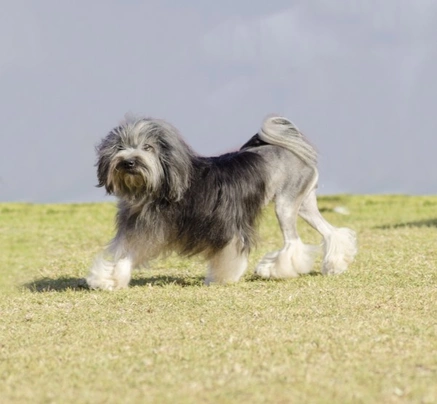Lowchen
Pros
Cons
Introduction of the Lowchen
The Lowchen, commonly known as the Little Lion Dog, captivates with its distinctive lion-like clipped coat and cheerful, affectionate personality. As one of the larger toy breeds, this small, sturdy dog combines elegance with a playful, loyal nature that endears it to families and companion dog enthusiasts alike. While its numbers remain limited, the Lowchen offers a charming mix of robust health and intelligent temperament, making it a wonderful choice for owners who can meet its grooming and exercise needs.
Originally bred as a companion dog, the Lowchen today thrives in family homes as an attentive companion, canine sports participant, and lively house pet. Its medium-length silky coat requires regular care, while its sociable and playful temperament suits active households willing to invest in daily mental and physical stimulation. Adaptable to city flats or country houses, Lowchens flourish under consistent training given their keen intelligence and eagerness to please.
This breed is best suited to those with the time and dedication to groom regularly and engage their dog in structured exercise and socialisation. Prospective owners should appreciate the breed's big-dog attitude in a small body, ensuring early socialisation to prevent potential assertiveness, particularly with other dogs. Responsible ownership also includes preparing for the breed's health screening and understanding its unique grooming and training requirements.
Perfect For
Families looking for a personable, loyal companion who enjoys active play sessions and is well-suited to city or suburban life. Lowchens also excel as candidates for canine sports such as agility and obedience, rewarding owners who provide consistent training and mental challenges.
Key Considerations
Requires regular grooming, ideally monthly professional trims, due to its dense, silky coat and traditional lion clip; needs early and ongoing socialisation to curb assertiveness and barking tendencies; prone to separation anxiety and thus best suited to homes where owners spend ample time with their dog; can be difficult to source puppies, often needing to join breeder waiting lists.
History of the Lowchen
The origins of the Lowchen are somewhat mysterious, with evidence tracing back to the 1500s in Europe, particularly France, Germany, and Spain. Known historically as the "Little Lion Dog" due to its unique lion-like lion trim, it is thought that companion dogs with such trimming were kept in Mediterranean and European societies for centuries. While some speculate an Eastern origin, historical artistic depictions strongly associate it with European roots and possibly linkage to the Bichon Frise.
Early Development
Around the early 20th century, enthusiasts began selectively breeding these small dogs with lion trims, but the breed's survival was precarious through both World Wars, during which numbers plummeted drastically. The iconic "lion clip" may have originated for practical reasons, including hygiene when these dogs were used as "hot water bottles" for warmth.Modern Recognition
The breed's revival is credited chiefly to Madame Bennert, who rescued the Lowchen from near extinction before and after WWII by founding a breeding programme from just three dogs with distinct coat colours. Their descendants, imported into the UK in the 1960s by Eillidh Stenning, form the foundation of all UK Lowchens today. The Kennel Club recognised the breed in 1971, with championship status soon following. Despite this, the Lowchen remains one of the rarest breeds globally, often necessitating a waiting list for prospective owners.Appearance of the Lowchen
Size and Build
The Lowchen stands between 28 to 35.6 cm tall at the withers, with males typically ranging from 30 to 35.6 cm and females from 28 to 33 cm. Weight varies, with males generally weighing 5.4 to 8.1 kg and females 4.5 to 6.8 kg, placing the breed as one of the larger toy dogs. It boasts a well-balanced, muscular, and sturdy frame with a level topline and well-proportioned body. Forequarters are compact and sturdy featuring well-laid-back shoulders and straight forelegs with good bone density. The hind limbs are muscular and strong with compact, round feet providing excellent stability.
Coat and Colours
The Lowchen's coat is a distinctive long, wavy single coat that feels soft and silky to the touch. It is often presented in the traditional "lion clip," leaving hair around the chest, head, front legs, and tail resembling a plume, which highlights the breed's unique look. When unclipped, the coat appears long and slightly scruffy, adding character. Kennel Club recognised colours include black, black & cream, brindle, brown, cream, gold, parti-colour, silver, white, among many combinations, except merle, which is disallowed. The breed standard permits any colour combination with no limitation other than the merle exclusion.
Distinctive Features
The Lowchen has a short, broad head with a flat skull between moderately spaced ears. It features a clearly defined stop and a short, strong muzzle with a perfect scissor bite. The eyes are dark, round, and expressive, conveying intelligence and alertness. Ears are moderately long and hang down with attractive fringes. A proudly arched, moderately long neck supports carriage. The tail is moderately long, usually clipped to leave a plume-like tuft, and carried gaily when the dog is alert or moving. The breed moves with a free, parallel gait front and back showing effortless agility and balance.
Gender Differences
Males tend to be slightly taller and heavier with a more robust build, while females are more delicate in appearance but equally alert and elegant. Temperamentally, males may show more dominance if not properly socialised, whereas females often exhibit a more reserved character but remain playful and engaged companions.
Breed Standard and Show Preferences
The Kennel Club breed standard emphasises health, balance, and movement, discouraging exaggerated features that could compromise wellbeing or function. Judges in the show ring favour dogs with smooth, flowing gaits and well-maintained lion trims, reflecting the breed's unique heritage and personality.
Temperament of the Lowchen
The Lowchen is renowned for its affectionate and intelligent nature, perfectly blending a small dog's size with a surprisingly big personality. It is outgoing, loyal, and thrives on interaction with its family, making it an excellent companion for those seeking a responsive and engaging pet.
Its intelligence and eagerness to please render it highly trainable, excelling in canine sports such as agility, obedience, and heelwork to music. Playfulness and a clownish charm persist throughout their lives, lending a very enjoyable canine companion that enjoys attention and mental stimulation.
Socially, Lowchens are friendly with people and other dogs when well socialised from a young age but can display assertiveness or stubbornness if not exposed properly to various experiences. Early and continued socialisation is crucial to prevent behaviours such as excessive barking or guarding tendencies, as they possess a watchdog instinct but generally lack aggression towards visitors.
Lowchens form deep bonds with their families and dislike being left alone for prolonged periods, often leading to separation anxiety and potentially destructive behaviour if isolated. They enjoy water and swimming but should always be supervised near dangerous bodies of water due to their curious nature.
They adapt well to different living environments, including apartments, providing they receive sufficient daily exercise and mental challenges to stave off boredom. Their confident, playful temperament and moderate prey drive make them wonderful companions, but they do require consistent, gentle training and attention.
Intelligence / Trainability of the Lowchen
Lowchens are intelligent and eager to please, making training a rewarding experience when approached correctly. Success lies in applying gentle, positive reinforcement techniques as this breed does not respond well to harsh punishment or heavy-handed methods, which can lead to stress or stubborn behaviour.
Puppy Training Priorities
Early socialisation is vital to expose puppies to various people, environments, and other animals once vaccinations are complete, ideally beginning around 10 to 12 weeks of age. Foundational commands such as sit, stay, come, heel, quiet, and leave it should be introduced early to establish boundaries and manners, preventing small dog syndrome.Training Methods That Work
Maintaining short, varied, and engaging sessions helps keep a Lowchen focused and motivated. Healthy treats and praise are excellent motivators, and consistency is key to reinforce positive behaviour. Avoid repetitive drill sessions that may cause boredom or disinterest.Advanced Training Potential
Lowchens thrive in canine sports including agility, obedience, and heelwork to music competitions. Their intelligence and playful nature also make them good candidates for therapy roles and other advanced training challenges requiring both focus and adaptability.Common Training Mistakes
Overindulgence early on can lead to spoiled puppies who challenge household rules later. Neglecting socialisation risks developing shy or overly assertive adults. Harsh training or punishment can damage trust and obstruct progress.Children and other
The Lowchen is an excellent companion for children of all ages, forming strong bonds and participating joyfully in play. Their clownish, fun-loving demeanour makes them popular playmates, especially with older children who appreciate their energetic antics. Supervised interactions are essential with toddlers to prevent accidental knocks or roughhousing due to the dog's lively nature.
The breed generally coexists well with other pets, including cats, particularly when raised together from puppyhood. While most Lowchens tolerate household cats, they may chase unfamiliar felines due to instinctual prey drives, so caution is advised with new introductions.
Health of the Lowchen
The average lifespan of a Lowchen ranges from 12 to 14 years, reflecting the breed's overall robustness. Known as a generally healthy breed, Lowchens do have a few hereditary conditions to be mindful of, notably hip dysplasia and luxating patella, both common in small and toy breeds. Progressive Retinal Atrophy (PRA) and cataracts occasionally affect some individuals, impacting vision over time.
Genetic testing and regular veterinary screenings are crucial preventive measures. The UK Kennel Club recommends that breeders hip score parents to maintain below-average scores relative to the breed mean and conduct annual BVA eye tests. The average coefficient of inbreeding (COI) stands at 18.6%, signalling the importance of genetic diversity in breeding programs.
Vaccination schedules follow standard protocols, with puppies receiving initial vaccinations before sale and owners responsible for timely follow-ups. Spaying and neutering are generally advised between 6 to 9 months to allow physical maturity, but vets may tailor timing based on individual health status.
Owners should watch for allergies to food or environmental triggers such as pollens and dust mites, which can provoke skin or respiratory issues. Early identification and vet care are key in managing these conditions effectively.
Genetic Testing Recommendations
Recommended tests include hip scoring, PRA eye examinations, and BAER testing for congenital deafness, helping safeguard future generations from hereditary defects. Responsible breeders adhere to these protocols to support the breed's long-term health and welfare.
Insurance and Preventive Healthcare
Due to their generally good health, Lowchens are considered moderate risk for insurance with premiums affected by age, sex, location, and neuter status. Preventive care includes regular vaccinations, dental health checks, parasite controls, and weight management to avoid obesity-related complications, which can shorten lifespan.
Caring for the Lowchen
Proper care for the Lowchen involves consistent grooming, daily exercise, and attentive health monitoring to maintain peak condition. Their coat requires regular brushing to prevent mats and tangles, especially if the traditional lion clip is not kept; monthly visits to a professional groomer help maintain breed-appropriate trims and skin health.
Daily Routine
Lowchens thrive with structured daily walks totaling around 40 to 60 minutes and freedom to explore safely in a secure garden. Playtime and mental stimulation, such as training sessions or interactive toys, are vital to prevent boredom and undesirable behaviours. Puppy-proofing environments and gradual socialisation enable confident growth from a young age.Living Environment
Adaptable to apartments or larger homes, the Lowchen benefits from a secure garden area for play and exercise. They are sensitive to noise, so maintaining a calm home atmosphere supports their well-being. Climate considerations include protection from extreme cold or heat, with grooming adjusted seasonally to accommodate coat growth or shedding.Senior Care
As they age, Lowchens require adaptations such as softer bedding, adjusted diet with balanced nutrition for older dogs, and joint support supplements to maintain mobility and comfort. Regular vet visits ensure timely detection of age-related conditions such as arthritis or dental issues, with exercise tailored to older dogs' reduced stamina.Grooming of the Lowchen
The Lowchen's grooming demands are significant, particularly when maintained in the iconic lion clip, which should ideally be executed by professional groomers every 4 to 6 weeks for optimal appearance and coat health. Long coats left unclipped require daily brushing using slicker brushes or combs to prevent mats and tangles, while a simpler "puppy cut" can ease maintenance between professional trims.
Regular checking and cleaning of ears prevent wax build-up and infections, a common problem if neglected. Ear care involves gentle cleansing with vet-approved solutions and monitoring for irritation. Nail trimming, dental hygiene with dog-specific toothpaste, and bathing with breed-appropriate shampoo complete the routine care to keep the Lowchen healthy and comfortable.
Home grooming tools recommended include a grooming glove for daily upkeep, soft bristle brushes, rounded-end scissors, and quality nail clippers. Owners should watch for common issues such as matting, skin allergies, or seasonal shedding fluctuations, addressing problems promptly through professional advice or care adjustments.
Exercise of the Lowchen
The Lowchen requires moderate daily exercise, typically 40 to 60 minutes, to satisfy its physical and mental needs. This often includes a shorter morning walk complemented by a more stimulating, longer afternoon outing with opportunities for off-lead exploration. Access to a secure garden provides additional freedom for play and energy release.
Exercise should be age-appropriate, avoiding over-exertion in puppies to protect developing joints and bones. As an intelligent breed, Lowchens benefit from varied activities that combine physical movement with mental challenges. Suitable activities include agility training, obedience exercises, and interactive games that foster their natural curiosity and eagerness to participate.
Mental stimulation through puzzle toys, training tasks, and social interaction helps prevent boredom that could manifest as destructive behaviours. Owners should monitor signs of fatigue or stress, adjusting exercise routines to the individual dog's health and energy levels across life stages.
Feeding of the Lowchen
The diet of a Lowchen must be carefully managed for healthy growth, maintenance, and longevity. Puppies require high-quality, nutrient-dense food formulated for small breeds, ideally fed in 3 to 4 meals daily with portion sizes adjusted monthly to suit growth needs. Transition to adult feed occurs around 11 months of age.
Adult Lowchens should be offered balanced meals twice daily with calorie intake tailored to weight and activity to prevent obesity, a common risk in smaller breeds. High-quality proteins, moderate fat, and essential vitamins and minerals support the breed's energy and coat condition. Avoiding filler-heavy foods and gradual diet changes minimise digestive issues.
Older Lowchens need diets with adjusted protein and fat content to maintain health, typically 14-21% protein, less than 10% fat, and controlled mineral levels as outlined in breed care guides. Supplements for joint health may be beneficial in senior dogs.
Special Dietary Considerations
Some Lowchens may develop allergies to certain foods or environmental factors, requiring veterinary guidance to identify triggers and adjust diets accordingly. Treats used for training should be healthy and offered in moderation to avoid weight gain.
Weight Management
Regular monitoring of body condition is essential to avoid obesity which can shorten lifespan and lead to arthritis and cardiac strain. Owners are advised to adjust food portions and increase exercise if weight gain is observed.
Lowchen price
The cost of acquiring a Lowchen puppy in the UK typically ranges between £800 and £1,500 depending on breeder reputation and pedigree quality. Due to the breed’s rarity, prospective buyers often face waiting lists, contributing to higher prices.
Initial setup costs include essential equipment such as quality grooming tools, dog beds, feeding bowls, leads, and toys, which can add up to approximately £200 to £400. Professional grooming appointments, common for maintaining the iconic lion clip, might cost £40 to £70 per session and are recommended every 4 to 6 weeks.
Monthly expenses usually range from £50 to £90 covering high-quality food, routine vet check-ups, parasite preventatives, and insurance. Insurance premiums vary by age, region, and coverage type, with average rates around £23 per month for basic cover and £53 for lifetime policies.
Veterinary costs including vaccinations, neutering, dental care, and unexpected health issues can add around £900 annually. Budgeting for these recurring and unexpected expenses is essential for responsible ownership.
You can find Lowchen for sale on Pets4Homes where reputable breeders list puppies with pedigree documentation.
Buying advice
When purchasing a Lowchen puppy, thorough research and caution are imperative due to the breed’s rarity and the prevalence of unscrupulous sellers. Always seek puppies from reputable breeders who provide full health clearances, pedigree documentation, and allow you to meet both the puppy and its dam in their home environment.
Avoid purchasing puppies unseen or from sellers requesting upfront deposits without any assurance or contract. Verify vaccination records, worming schedules, and microchip information as part of the buying process. Be wary of unrealistically small puppies, as these may suffer health complications and stem from irresponsible breeding.
Finding Ethical Breeders
Prospective owners should ask for details on breeding frequency, health testing results (including hip scoring and eye testing), and breeder affiliations. The Kennel Club rules limit dams to four litters within specified age ranges to protect welfare.Health Testing Verification
Request documentation for parental health clearances such as BVA hip scores, PRA eye tests, and BAER testing to prevent inherited conditions. Buyers can check Kennel Club databases and breed clubs for proven breeders.Puppy Selection Process
Temperament assessment is crucial; choose puppies who display confidence, sociability, and no signs of excessive shyness or aggression. Health checks and veterinary examination records from breeders are essential.Contract and Guarantee Review
Ensure contracts include health guarantees, return policies, and spay/neuter agreements where applicable. Watch for red flags like vague terms or lack of paperwork.Rescue and Adoption Options
While rare, Lowchen rescues exist, and adopting an adult dog can be a rewarding alternative, providing a loving home to a dog in need. Check breed-specific rescues and general dog rescue centres for available Lowchens.You can find Lowchen for sale from trusted breeders through Pets4Homes.



